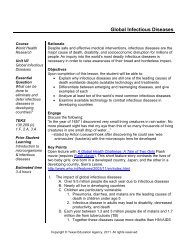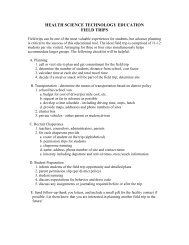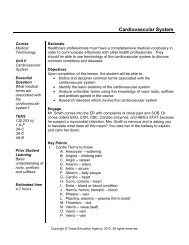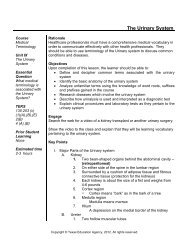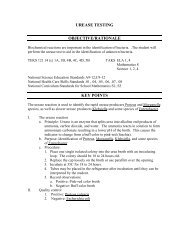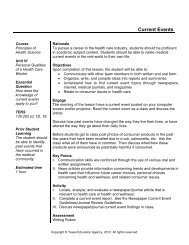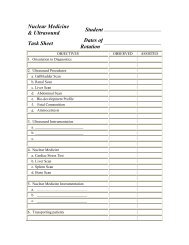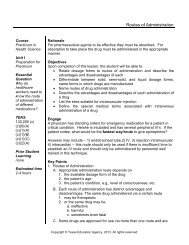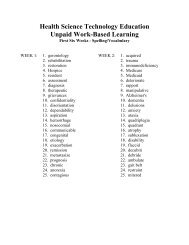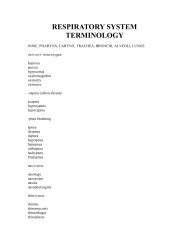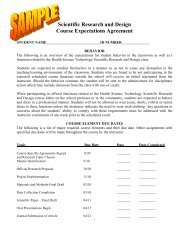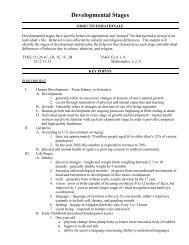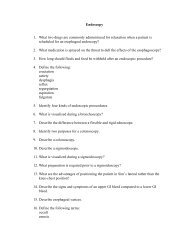Parliamentary Procedure III - Texas Health Science!
Parliamentary Procedure III - Texas Health Science!
Parliamentary Procedure III - Texas Health Science!
You also want an ePaper? Increase the reach of your titles
YUMPU automatically turns print PDFs into web optimized ePapers that Google loves.
<strong>Parliamentary</strong> <strong>Procedure</strong>: Lesson Three<br />
Course<br />
<strong>Health</strong> <strong>Science</strong><br />
Unit I<br />
Leadership<br />
Essential<br />
Question<br />
Do I know how<br />
to conduct<br />
myself in a<br />
professional<br />
business<br />
meeting?<br />
TEKS<br />
130.204(c)10B,<br />
10C<br />
Prior Student<br />
Learning<br />
A basic<br />
understanding of<br />
a professional<br />
business<br />
meeting.<br />
<strong>Parliamentary</strong><br />
<strong>Procedure</strong><br />
Lessons 1 and 2<br />
Estimated time<br />
1.5 – 2 hours<br />
Rationale<br />
A thorough understanding of <strong>Parliamentary</strong> <strong>Procedure</strong> is necessary in the<br />
orderly conduction of business meetings.<br />
Objectives<br />
Upon completion of this lesson, the student will be able to:<br />
Understand principles of <strong>Parliamentary</strong> <strong>Procedure</strong><br />
Formulate basic motions using <strong>Parliamentary</strong> <strong>Procedure</strong><br />
Engage<br />
In small groups, make a list of places where parliamentary procedure is<br />
regularly used. What do they have in common? How are they different? Do<br />
you think these organizations could run as effectively without parliamentary<br />
procedure? Compare answers as a class.<br />
Key Points<br />
I. Motions<br />
A. Bring business to an assembly in an orderly manner<br />
B. The main types of motions in <strong>Parliamentary</strong> <strong>Procedure</strong><br />
1. Main motions<br />
2. Subsidiary<br />
3. Privileged<br />
4. Motions that Bring a Question before the assembly again<br />
5. Incidental<br />
C. Motions are ranked – within each rank the types of motions<br />
also have ranking<br />
1. Highest ranking are privileged<br />
2. Next highest are subsidiary<br />
3. Main motions have no rank<br />
4. Incidental motions really have no rank as well<br />
D. Motions begin with the words “I move that . . . . . .”<br />
E. Motions are short and to the point – no discussion or excessive<br />
description is needed. This can be included in the debate<br />
after.<br />
F. Only one motion can be considered at a time – sequence of<br />
what should be considered is determined by the rank – highest<br />
to lowest. Thus main motions are considered last, because<br />
they have no ranking.<br />
II. Ranked motions<br />
A. Main motions – introduce all business<br />
B. Subsidiary motions – have to do with another motion<br />
Copyright © <strong>Texas</strong> Education Agency, 2012. All rights reserved.
1. Modify the motion<br />
2. Delay action on it<br />
3. Dispose of it<br />
C. Privileged motions – have to do with the conduction of the<br />
meeting itself, and have to do with such emergency that they<br />
interrupt everything else.<br />
D. Incidental motions deal with questions of procedure and arise<br />
out of another motion or item of business<br />
<strong>III</strong>. Main motions<br />
A. Require a second – if not received, the motion dies<br />
B. Are debatable<br />
C. Are amendable<br />
D. Require a majority vote<br />
E. May be reconsidered<br />
F. Cannot interrupt a speaker – must wait for the floor to be<br />
yielded, and the one introducing the main motion must gain the<br />
floor<br />
IV. Subsidiary Motions – are related to other motions – applied to other<br />
motions<br />
A. Lay on the Table – delay action on another motion because<br />
something more important has arisen<br />
1. Requires a second<br />
2. Is not debatable<br />
3. Is not amendable<br />
4. Cannot be reconsidered<br />
5. Cannot interrupt another speaker<br />
B. Previous Question – requires an immediate vote on another<br />
motion<br />
1. Requires a second<br />
2. Is not debatable<br />
3. Is not amendable<br />
4. Passed by a 2/3 vote<br />
5. Cannot interrupt another speaker<br />
6. State “I move the previous question”<br />
C. Postpone definitely – defers action on another motion to a<br />
specific day, place, and time<br />
1. Requires a second<br />
2. Is not debatable<br />
3. Is amendable<br />
4. 2/3 vote required because it restricts<br />
5. May be reconsidered<br />
6. Cannot interrupt one who has the floor<br />
D. Commit or refer – gives a motion more detailed attention or<br />
permits it to be handled privately<br />
1. Requires a second<br />
2. Is debatable<br />
Copyright © <strong>Texas</strong> Education Agency, 2012. All rights reserved.
3. Is amendable<br />
4. Majority vote required<br />
5. May be reconsidered<br />
6. Cannot interrupt one who has the floor<br />
E. Amendments – change a main motion by inserting, adding,<br />
striking, and substituting<br />
1. Require a second<br />
2. Is debatable if the main motion is debatable<br />
3. Amendment of the first degree may be amended by<br />
amendment of the second degree<br />
4. Second degree amendments cannot be amended<br />
5. Related to motion pending<br />
6. Majority vote required<br />
7. May be reconsidered only until the main motion is<br />
adopted; otherwise, the whole main motion may be<br />
reconsidered<br />
8. May not interrupt one who has the floor<br />
F. Postpone indefinitely – disposes of the question without having<br />
to vote on it<br />
1. Requires a second<br />
2. Is debatable<br />
3. Is not amendable<br />
4. Majority vote required<br />
5. Cannot be reconsidered<br />
6. Cannot interrupt one who has the floor<br />
V. Privileged Motions – have to do with the conduct of the meeting, and<br />
any other pressing issues that require immediate attention<br />
A. Adjourn – terminates the meeting<br />
1. “I move that we adjourn”<br />
2. Requires a second<br />
3. Not debatable<br />
4. Not amendable<br />
5. Majority vote required<br />
6. Cannot be reconsidered<br />
7. Cannot interrupt one who has the floor<br />
B. Recess – permits a short intermission<br />
1. Requires a second<br />
2. Not debatable<br />
3. Not amendable<br />
4. Majority vote required<br />
5. Cannot be reconsidered<br />
6. Cannot interrupt one who has the floor<br />
VI. Motions that bring a question before the assembly again<br />
A. Reconsider – allows a question previously disposed of to come<br />
again before the assembly as if it had not been considered.<br />
Can only be made by a member who voted on the prevailing<br />
Copyright © <strong>Texas</strong> Education Agency, 2012. All rights reserved.
side, and only on the same day the original vote was taken<br />
1. Requires a second<br />
2. Is debatable only if the original motion to be reconsidered<br />
is debatable<br />
3. Is not amendable<br />
4. Majority vote required<br />
5. Cannot be reconsidered<br />
6. Cannot interrupt one who has the floor<br />
B. Rescind – voids a motion previously passed<br />
1. Requires a second<br />
2. Is debatable<br />
3. Is amendable<br />
4. Simple majority if prior notice given, or 2/3 if not<br />
5. Only a negative vote can be reconsidered<br />
6. Cannot interrupt a speaker who has the floor<br />
C. Take from the table<br />
1. Requires a second<br />
2. Is not debatable<br />
3. Is not amendable<br />
4. Majority vote<br />
5. Cannot be reconsidered<br />
6. Cannot interrupt a speaker who has the floor<br />
VII. Incidental Motions<br />
A. Point of information – wants facts about the business at hand<br />
1. “I rise to a point of information”<br />
2. Can happen at any time<br />
B. <strong>Parliamentary</strong> Inquiry – requests chair’s opinion, not a ruling on<br />
a matter regarding the business at hand<br />
1. Can happen at any time<br />
C. Division of Assembly – calls for verification when a member<br />
doubts the accuracy of a voice vote<br />
1. Can happen after a voice vote is taken<br />
D. Withdraw a motion – permits a member to remove his or her<br />
question from consideration, even after the motion has been<br />
restated by the chair.<br />
1. “Madam President, I move that I be allowed to withdraw<br />
the motion.”<br />
E. Point of Order – Challenges an error in procedure and requires<br />
a ruling by the chair.<br />
1. “I rise to a point of order,” or, “Point of Order”<br />
Copyright © <strong>Texas</strong> Education Agency, 2012. All rights reserved.
Teacher Note:<br />
Make enough<br />
sets of motions<br />
for class groups<br />
of 3-4. Cut the<br />
motions into<br />
strips and<br />
laminate so the<br />
sets can be<br />
reused.<br />
Activity<br />
I. Participate in the Name the Question Multimedia Game. (Game 1,<br />
Game 2, Game 3)<br />
II.<br />
Divide the class in to groups of 3-4. Rank motions in order starting<br />
with the highest. (List of Motions 1, List of Motions 2, List of Motions<br />
3, List of Motions 4)<br />
Assessment<br />
Member of a Team Rubric<br />
Materials<br />
Handouts : Classification of Motions<br />
Multimedia Presentation : <strong>Parliamentary</strong> <strong>Procedure</strong> <strong>III</strong><br />
Accommodations for Learning Differences<br />
For reinforcement, the students will list the motions in ranking order.<br />
For enrichment, the students will select one motion and design a role play,<br />
rhyme, or some creative way to remember all of the points of that motion.<br />
National and State Education Standards<br />
National <strong>Health</strong> <strong>Science</strong> Cluster Standards<br />
HLC07.01 Leadership and Teamwork<br />
<strong>Health</strong> care workers will understand the roles and responsibilities of<br />
individual members as part of the health care team, including their ability to<br />
promote the delivery of quality health care.<br />
TEKS<br />
130.204(c)(10)B participate in group dynamics; and<br />
130.204(c)(10)C integrate consensus-building techniques.<br />
<strong>Texas</strong> College and Career Readiness Standards<br />
Social Studies Standards<br />
E4. Identify and evaluate the sources and consequences of social conflict.<br />
Copyright © <strong>Texas</strong> Education Agency, 2012. All rights reserved.
List of Motions 1<br />
LAY ON THE TABLE<br />
PREVIOUS QUESTION<br />
POSTPONE DEFINITELY<br />
COMMIT/REFER<br />
Correct order: Lay on the Table<br />
Previous Question<br />
Commit/Refer<br />
Postpone Definitely<br />
Copyright © <strong>Texas</strong> Education Agency, 2012. All rights reserved.
List of Motions 2<br />
AMENDMENT<br />
POSTPONE INDEFINITELY<br />
ADJOURN<br />
RECESS<br />
Correct Order: Adjourn<br />
Recess<br />
Amend<br />
Postpone Indefinitely<br />
Copyright © <strong>Texas</strong> Education Agency, 2012. All rights reserved.
List of Motions 3<br />
PARLIAMENTARY INQUIRY<br />
DIVISION OF ASSEMBLY<br />
WITHDRAW A MOTION<br />
POINT OF ORDER<br />
Correct Order: Incidental Motions- they have no rank<br />
Copyright © <strong>Texas</strong> Education Agency, 2012. All rights reserved.
List of Motions 4<br />
Main Motion<br />
Refer to Committee<br />
Amend<br />
Adjourn<br />
Correct order: Adjourn<br />
Refer to committee<br />
Amend<br />
Main Motion<br />
Copyright © <strong>Texas</strong> Education Agency, 2012. All rights reserved.
Types of Motions Brought to Assemblies (Handout)<br />
Four main types of motions: Main, subsidiary, privileged, and incidental.<br />
Motions are ranked – some have higher precedence than others. The highest ranking is<br />
privileged, followed by subsidiary, and then main. Incidental motions don’t really have a ranking,<br />
much like the main motion. Only one motion can be considered at a time; the sequence in which<br />
motions may be taken up is determined by their ranking – highest to lowest. So the main motion<br />
is the last motion to be considered, because it has no ranking.<br />
Main Motions<br />
Have no rank – all other motions take precedence over main motions<br />
Introduce new business to an assembly<br />
Introduced by anyone in the group<br />
Begin with the words “I move that. . . .”<br />
Main motions:<br />
A. Require a second<br />
B. Are debatable<br />
C. Are amendable<br />
D. Require a majority vote<br />
E. May be reconsidered<br />
F. Cannot interrupt a speaker – must wait until the floor is yielded, and then the one<br />
who introduces the motion must gain the floor.<br />
Subsidiary Motions<br />
May be applied to another motion for the purpose of modifying it, delaying action on it, or<br />
disposing of it<br />
Have a specific order of precedence<br />
Lay on the Table (Highest subsidiary motion) – the motion to postpone an item of<br />
business because something more important has arisen<br />
A. Requires a second<br />
B. Not debatable<br />
C. Not amendable<br />
D. Cannot be reconsidered<br />
E. Cannot interrupt one who has the floor<br />
Previous Question (motion, if passed, orders an immediate vote)<br />
A. Requires a second<br />
B. Not debatable<br />
C. Not amendable<br />
D. Passed by a 2/3 vote<br />
E. Cannot interrupt one who has the floor<br />
F. “I move the previous question” means lets vote<br />
Copyright © <strong>Texas</strong> Education Agency, 2012. All rights reserved.
Limit or extend limits of debate – both number and length of speeches<br />
A. Requires a second<br />
B. Not debatable<br />
C. Is amendable<br />
D. 2/3 vote for adoption<br />
E. May be reconsidered<br />
F. Cannot interrupt one who has the floor<br />
Postpone definitely – defers to a definite day, place, and time.<br />
A. Requires a second<br />
B. Is debatable<br />
C. Is amendable<br />
D. Majority vote required<br />
E. May be reconsidered<br />
F. Cannot interrupt one who has the floor<br />
Commit or refer – gives a motion more detailed attention, or permits it to be handled<br />
privately<br />
A. Requires a second<br />
B. Is debatable<br />
C. Is amendable<br />
D. Majority vote required<br />
E. May be reconsidered<br />
F. Cannot interrupt one who has the floor<br />
Amendments – modify a main motion by inserting, adding, striking, and substituting<br />
A. Requires a second<br />
B. Is debatable if the main motion is debatable<br />
C. Amendment of the first degree may be amended by amendment of the second<br />
degree<br />
D. Second degree cannot be amended<br />
E. Related to the motion pending<br />
F. Majority vote required<br />
G. May be reconsidered only until the main motion is adopted; otherwise, the whole<br />
main motion may be reconsidered<br />
H. Cannot interrupt one who has the floor<br />
Postpone indefinitely – disposes of a question without having to vote on it<br />
A. Requires a second<br />
B. Is debatable<br />
C. Not amendable<br />
D. Majority vote required<br />
E. Cannot be reconsidered<br />
F. Cannot interrupt one who has the floor<br />
Copyright © <strong>Texas</strong> Education Agency, 2012. All rights reserved.
Privileged Motions<br />
Adjourn – terminates the meeting<br />
A. “I move that we adjourn”<br />
B. Requires a second<br />
C. Not debatable<br />
D. Not amendable<br />
E. Majority vote required<br />
F. Cannot be reconsidered<br />
G. Cannot interrupt one who has the floor<br />
Recess – permits a short intermission<br />
A. Requires a second<br />
B. Not debatable<br />
C. Is amendable<br />
D. Majority vote required<br />
E. Cannot be reconsidered<br />
F. Cannot interrupt one who has the floor<br />
Raise a question of privilege – bringing an important issue before the assembly that is<br />
related to the members rights and privileges – needs to have immediate consideration<br />
A. Does not require a second<br />
B. Is not debatable<br />
C. Is not amendable<br />
D. No vote required for this – only on the question being brought<br />
E. Cannot be reconsidered<br />
F. Cannot interrupt one who has the floor<br />
Call for the order of the day<br />
A. Does not require a second<br />
B. Is not debatable<br />
C. Is not amendable<br />
D. 2/3 vote required<br />
E. Cannot be reconsidered<br />
F. Cannot interrupt one who has the floor<br />
Copyright © <strong>Texas</strong> Education Agency, 2012. All rights reserved.
Motions That Bring a Question Before the Assembly Again<br />
Reconsider – allows a question previously disposed of to come again before the<br />
assembly as if it had not been considered. Can only be made by a member who voted on<br />
the prevailing side, and only on the same day the original vote was taken.<br />
A. Requires a second<br />
B. Is debatable only if the original motion to be reconsidered is debatable<br />
C. Not amendable<br />
D. Majority vote required<br />
E. Cannot be reconsidered<br />
F. Cannot interrupt another speaker with the floor<br />
Discharge a committee – take a matter out of a committee’s hands<br />
A. Requires a second<br />
B. Is debatable<br />
C. Is amendable<br />
D. Simple majority if prior notice given, or 2/3 vote<br />
E. Only a negative vote can be reconsidered<br />
F. Cannot interrupt a speaker who has the floor<br />
Rescind – voids a previously passed motion<br />
A. Requires a second<br />
B. Is debatable<br />
C. Is amendable<br />
D. Simple majority if prior notice given, or 2/3 vote<br />
E. Only a negative vote can be reconsidered<br />
F. Cannot interrupt a speaker who has the floor<br />
Take from the table<br />
A. Requires a second<br />
B. Is not debatable<br />
C. Is not amendable<br />
D. Majority vote<br />
E. Cannot be reconsidered<br />
F. Cannot interrupt a speaker who has the floor<br />
Copyright © <strong>Texas</strong> Education Agency, 2012. All rights reserved.
Incidental Motions<br />
Point of information<br />
A desire for facts about the business at hand<br />
“I rise to a point of information.”<br />
Can happen at any time<br />
<strong>Parliamentary</strong> Inquiry<br />
Requests the chair’s opinion<br />
Not a ruling on a matter regarding the business at hand<br />
Can happen at any time<br />
Division of Assembly<br />
Calls for verification when a member doubts the accuracy of a voice vote<br />
Can happen after a voice vote is taken<br />
Withdraw a motion<br />
Permits a member to remove his or her question from consideration even after the<br />
motion has been restated by the chair<br />
“Madam President, I move that I be allowed to withdraw the motion.”<br />
Suspend the rules<br />
Temporarily sets aside a rule to permit the assembly to take an action it could not<br />
otherwise take<br />
“I move to suspend the rules which interfere with considering the motion to hold a<br />
get-acquainted happy hour for new members.”<br />
Requires a 2/3 vote and cannot be reconsidered.<br />
Appeal from the ruling of the chair<br />
Challenges a ruling of the chair<br />
A majority vote sustains the ruling.<br />
“I appeal from the decision of the chair.”<br />
Point of Order<br />
Challenges an error in procedure<br />
Requires a ruling by the chair.<br />
“I rise to a point of order,” or, “Point of Order!”<br />
Copyright © <strong>Texas</strong> Education Agency, 2012. All rights reserved.



